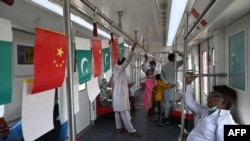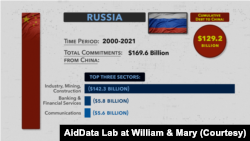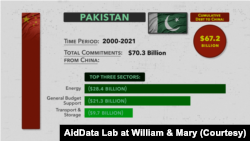Russia, Venezuela and Pakistan are the top three recipients of Chinese development funding in the past two decades, but the crisis-riddled countries may be losing attraction for Beijing.
China is moving to protect its global investments under the Belt and Road Initiative, according to a study released this week by AidData, a research lab at the U.S. university, William and Mary. The research shows that China gave $1.34 trillion dollars in grants and loans for more than 20,000 projects to 165 low-income and middle-income countries between 2000 and 2021.
While the top three recipients received funding for different reasons, AidData senior researcher Ammar Malik told VOA, "In the global chess board of great power competition between the U.S. and China, every country matters."
Russia
With nearly $170 billion in development loans, Russia received the biggest chunk of Chinese funding over two decades.
Russia tops the list because China sees it as "strategically important" and Chinese funding is "one of the few options available" to it, Yun Sun, director of the China Program at the Washington-based Stimson Center, wrote to VOA.
China invested most heavily in the Russian industry, mining and construction sectors followed by banking and financial services, and communications.
Unlike many low and middle-income countries that rely on Chinese investments and aid for their domestic needs, the bulk of funding to Russia supports industries that export to China.
Although Russia has seen a drop in Chinese development funding over the years, Moscow will keep courting Beijing, said Ali Wyne, senior analyst with Eurasia Group's Global Macro-Geopolitics practice.
"Russia believes that it can advance its great-power pretensions by deepening its ties to China, which is the only country that might eventually be able to contest the United States for global preeminence," Wyne told VOA in a written statement.
Moscow's debt to Beijing totals almost $130 billion, or 7.3% of its GDP. However, the lack of grants to Russia speaks to the strength of the Russian economy and shows that China expects economic gains by investing there, according to AidData.
But Beijing's deepening economic and strategic ties with Russia come with a cost, Wyne noted.
"Russia's ongoing aggression against Ukraine has significantly undermined China's relationships with the United States and the European Union," he said.
Venezuela
With almost $113 billion in investments from China in the past two decades, Venezuela is the second-largest recipient of Beijing's credit and aid.
In AidData's report, the bulk of China's funding went to multisector projects that do not fall into any specific category due to a lack of information from Beijing, followed by the sector titled "industry, mining and construction."
Venezuela has the world's largest volume of proven oil reserves, and the country's rapid growth - 14 percent in 2007 - made it attractive for Beijing to invest there, Wyne told VOA.
However, the third-largest chunk of Chinese spending in Venezuela went to budgetary support to save its economy. This reflects a trend seen in many recipients of Chinese funds.
"This rescue lending is intended to keep the whole financial system in these countries afloat so that they can repay the loans that they had taken on in the previous years," said Malik.
According to AidData, more than half of China's loans to low and middle-income countries have entered a repayment phase, but many of the borrowers are unable to pay back the debt. This has forced Beijing, the world's single biggest creditor, to spend less on infrastructure projects under its global Belt and Road Initiative — known as BRI — launched in 2013, and more on rescuing countries in financial distress.
"The collapse of oil prices between mid-2014 and late 2015 as well as the economic mismanagement under President Nicolás Maduro undercut Venezuela's ability to make loan repayments to China, thereby making Beijing more cautious about its economic dealings with Caracas," Wyne said.
Since 2016, Caracas has seen a drop in Chinese funding.
Venezuela joined BRI in 2018. Yun Sun told VOA the South American country is not a key BRI target and will not be, for the foreseeable future.
Pakistan
With deep strategic, diplomatic and, lately, defense ties with China, Pakistan is the third-biggest recipient of Beijing's credit and aid totaling more than $70 billion.
Pakistan's 3,300-kilometer border with India to the east and the warm waters of the Arabian Sea to the south make this western neighbor of China an attractive choice for investment.
"Pakistan provides that long-term access into the Arabian Sea and through that into the Middle East for China," said Uzair Younus, director of the Pakistan Initiative at the Washington-based Atlantic Council. "In a world where India and U.S. continue to come closer together, there is basically a default approach that the Chinese will take towards Pakistan."
In the past two decades, China has invested most heavily in Pakistan's energy sector, followed by budget support and loans for projects in the transportation and storage sector.
Home to the China-Pakistan Economic Corridor, or CPEC, which many call the BRI's "crown jewel," the country has seen a dramatic rise in Chinese funding since 2014.
The Pakistani government's data indicates CPEC has so far created nearly 200,000 jobs, built more than 1,400 kilometers of highways and roads, and added 8,000 megawatts of electricity to the national grid. The country's deep-sea southwestern port of Gwadar, the centerpiece of CPEC, handled 600,000 tons of cargo in the past 18 months, according to officials.
Despite billions in Chinese development funding, Pakistan has struggled economically, barely escaping collapse this year.
Islamabad now owes China more than $67 billion which equals 19.6% of its economy. Experts say Beijing's heavy budgetary support to Islamabad — almost $21.3 billion in 22 years — is a sign that China does not want Pakistan to fail.
"The country that is basically building that crown jewel [CPEC] going into default or a disorderly default or an economic crisis is not good for the broader reputation of the BRI," Younus said.
As in Venezuela and other financially distressed recipients, Chinese development funding to Pakistan is drying up as Beijing focuses on keeping the country afloat.
"The attractiveness of Pakistan even in Chinese eyes has definitely taken a hit," Younus said, pointing to Chinese insurance company Sinosure's hesitation in providing coverage to new projects in Pakistan.
Future outlook
Malik sees Pakistan as a microcosm of what is happening around the world in countries with Chinese investments, especially since the launch of BRI.
"Our research shows that when China faces headwinds in the form of political instability on the ground or a country running into debt crisis, China generally backs down and reduces its commitments," Malik said.
China is looking to reduce the risks to its global investments, research shows. That means opting for countries that not only favor Beijing over Washington, but also provide a stable and secure environment for investments.










